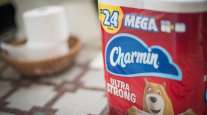Target, Like Walmart, Proves Main Engine of Economy Is Humming

[Stay on top of transportation news: Get TTNews in your inbox.]
Recession fears may be mounting in certain parts of the U.S. economy, but Walmart Inc. and Target Corp. are signaling that the all-important American consumer is doing just fine.
The big-box discount retailers both beat sales expectations for the second quarter and raised their profit guidance for the full year, shrugging off concerns about tariffs, encroachment from Amazon.com Inc. and dispiriting results from retail peers like Macy’s Inc., J.C. Penney Co. and Kohl’s Corp. Paired with bullish comments on the U.S. housing market this week from Home Depot Inc. and Lowe’s Corp., the outlook heading into the critical holiday period looks brighter.
“The consumer economy continues to motor along nicely,” said Neil Saunders, an analyst at Global DataRetail. “Home improvement is an early indicator of economic distress and from Home Depot’s numbers, there was no sign that the consumer is in a tailspin. Target and Walmart, both bellwethers for mainstream America, point to the same conclusion.”
Standing Out
Walmart, Target and Home Depot — along with a few other recent star performers like Costco Wholesale Corp. and Best Buy Co., which report in the coming weeks — have stood out by nailing the fundamentals of retail: price, assortment and convenience. Their products are affordable, with enough new stuff to keep people coming back, along with plenty of online buying options that appeal to busy shoppers. Plus their size and clout give them a leg up in negotiating tariff impacts with suppliers that smaller rivals don’t have.
Walmart and Target signal the state of the American consumer is just fine https://t.co/CRgdMmTfE0 pic.twitter.com/SVbWCmovCj — Bloomberg Markets (@markets) August 21, 2019
Take Target, which is remodeling 300 stores this year and has introduced about two dozen private and exclusive brands in key categories like apparel, home decor and booze. Or Walmart, which has figured out curbside fulfillment of grocery orders and will start offering in-home deliveries directly to shoppers’ fridges this fall. Those offers make them unique in the sea of sameness that has let Amazon and digital upstarts grab market share from other retailers in recent years.
Target shares surged as much as 18% in premarket trading after reporting results Aug. 21 and are poised to open at a record high. Lowe’s rose as much as 13%.
A recent survey of shoppers from analysts at Stifel confirms their appeal. More than eight out of 10 shoppers polled in late July said they plan to shop at Walmart in the next month, up from 71% who said the same two years ago. Target enjoyed a similar rate of increase in so-called shopping intention. More than one-quarter of consumers said they plan to spend more on discretionary items — stuff they want but don’t necessarily need — in the coming months, well above the 16% average over the past seven years.
“Our data suggests the U.S. consumer remains strong,” Stifel’s Mark Astrachan said in a note.
Comments from retail-industry leaders echoed that sentiment. Lowe’s CEO Marvin Ellison said Aug. 21 that the home-improvement retailer’s gains in the quarter reflected “a solid macroeconomic backdrop.” Walmart’s finance chief Brett Biggs said last week American consumers were in “relatively good shape.”
The bottom line is that consumers are still spending, but they’re getting more choosy and cautious, which is why even discounter TJX Cos. posted a rare stumble after failing to freshen up the assortment at its HomeGoods chain, forcing it to discount items. The miss at what’s traditionally an earnings standout showed how little margin for error there is in today’s unforgiving retail world.




